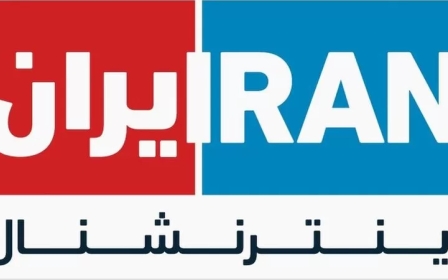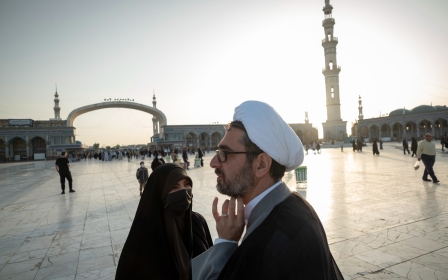Iran: Protesters' 'turban throwing' divides Mahsa Amini movement

Though Iran's Mahsa Amini protests have attracted wide support across Iranian society, one trend emerging in recent days has proved far more divisive: "turban throwing".
Some angry protesters, part of an unprecedented wave of demonstrations sparked by the death of 22-year-old Amini in police custody two months ago, have begun what they call a "movement" of running at clerics and knocking off their turbans.
Yet many demonstrators, who for the most part have been calling for an end to Iran's hijab law and so-called "morality police", have said the trend is "immoral".
Despite the controversy - or perhaps because of it - "turban throwing" is attracting increasing amounts of attention in the media and social media, while street protests seen over recent weeks have quietened somewhat.
Various videos have emerged showing several young women and boys running at clerics walking down the street, snatching their turbans and throwing them away. Some assailants are seen violently beating clerics.
New MEE newsletter: Jerusalem Dispatch
Sign up to get the latest insights and analysis on Israel-Palestine, alongside Turkey Unpacked and other MEE newsletters
Before the start of "turban throwing", clerics were being criticised and cursed in a series of protest songs. "Tanks, fire, bullets, mullahs must get lost" has been one of the most-used slogans in cities across Iran.
In Iran's theocratic Islamic Republic, the clergy hold influential and important positions throughout the establishment and authorities, including the supreme leadership.
Iranian media have reported that so far two people have been arrested for throwing turbans. "Knocking off the turbans from the heads of clerics is the conspiracy of devils," said Mohammad Taqi Naqd Ali, a principalist MP. Those responsible are "playing with the lion's tail", he added.
Fars, a Republican Guard-affiliated news agency, has begun a campaign urging officials to ensure clerics' safety and crack down on protesters who "insult" them.
Split opinions
Delaram, who has an online store and has frequently participated in the protests, believes "turban throwing" is a "natural reaction", and a smart tactic that gives clerics a taste of their own medicine.
"It's the same behaviour clerics treated women with over the past 40 years," she told Middle East Eye.
"For decades, they scared the hell out of us with their police forces, stopping us for our clothes and hijab. It is time for the clerics who encouraged and ordered this to experience our ordeal."
However, Parastoo, a protesting student in Tehran, told MEE: "Unfortunately, the result of turban throwing is to make the protests into something cheap. It is a pity, as we have righteous and important demands: a dignified life for all Iranians."
She added: "The clerics who are being attacked on the streets are innocent, as they are ordinary clerics who hold no governmental position. If they were inside the establishment, they wouldn't walk in the alleys and streets without any bodyguards.
"They may be even critical of the Islamic Republic."
A turbulent history
The targeting of clerics' turbans has history in Iran.
In the late 1990s and 2000s, Iranian principalists attacked their opponents and rivals on the streets, including some high-profile clerics.
In 1998, Hadi Khamenei, a reformist cleric known for his criticism of his brother, Supreme Leader Ayatollah Ali Khamenei, was attacked by plainclothes pressure groups with stones, shoes and knuckledusters in the holy city of Qom while he was giving a speech in a mosque. His turban was notably knocked off his head during the attack.
That same year, when reformist President Mohammad Khatami was in office, the hardline group Ansar Hezbollah, which was close to the principalist power centre, attacked and knocked the turban off Abdullah Nouri, the interior minister, during Friday prayers in Tehran.
'There are many clerics who are against the mandatory hijab and have spoken out against it and have been arrested'
- Political analyst
Later, during the controversial 2009 presidential election, principalists snatched the turban of reformist candidate Mahdi Karroubi while he was visiting Tehran's book fair.
A Tehran-based political analyst, who spoke on condition of anonymity for security reasons, said he could understand where the "turban throwing" movement came from.
"I cannot blame people for their anger as they have been living under pressure for decades, and they have now found an opportunity to vent their anger," the analyst said.
"But such moves are detrimental to the protests and the movement, as they scare some cautious people off joining the movement. And this all only benefits the government."
He added: "There are many clerics who are against the mandatory hijab and have spoken out against it and have been arrested. So the protestors shouldn't act based on excitement."
One issue, the analyst noted, was that the protest movement remains leaderless, so there's no one to pull demonstrators in a more palatable direction.:
"This situation may result in the empowerment of anti-democratic groups that are considered a minority among protesters. Their radical behaviour only benefits the Islamic Republic."
This article is available in French on Middle East Eye French edition.
Middle East Eye delivers independent and unrivalled coverage and analysis of the Middle East, North Africa and beyond. To learn more about republishing this content and the associated fees, please fill out this form. More about MEE can be found here.





